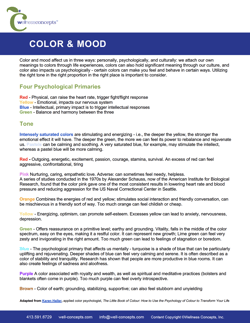Color and mood affect us in three ways: personally, psychologically, and culturally: we attach our own meanings to colors through life experiences, colors can also hold significant meaning through our culture, and color also impacts us psychologically - certain colors can make you feel and behave in certain ways. Utilizing the right tone in the right proportion in the right place is important to consider.
Four Psychological Primaries
Red - Physical, can raise the heart rate, trigger fight/flight response
Yellow - Emotional, impacts our nervous system
Blue - Intellectual, primary impact is to trigger intellectual responses
Green - Balance and harmony between the three
Tone
Intensely saturated colors are stimulating and energizing - i.e., the deeper the yellow, the stronger the emotional effect it will have. The deeper the green, the more we can feel its power to rebalance and rejuvenate us. Pastels can be calming and soothing. A very saturated blue, for example, may stimulate the intellect, whereas a pastel blue will be more calming.
Red - Outgoing, energetic, excitement, passion, courage, stamina, survival. An excess of red can feel aggressive, confrontational, tiring.
Pink - Nurturing, caring, empathetic love. Adverse: can sometimes feel needy, helpless. A series of studies conducted in the 1970s by Alexander Schauss, now of the American Institute for Biological Research, found that the color pink gave one of the most consistent results in lowering heart rate and blood pressure and reducing aggression for the US Naval Correctional Center in Seattle.
Orange - Combines the energies of red and yellow; stimulates social interaction and friendly conversation, can be mischievous in a friendly sort of way. Too much orange can feel childish or cheap.
Yellow - Energizing, optimism, can promote self-esteem. Excesses yellow can lead to anxiety, nervousness, depression.
Green - Offers reassurance on a primitive level; earthy and grounding. Vitality, falls in the middle of the color spectrum, easy on the eyes, making it a restful color. It can represent new growth; Lime green can feel very zesty and invigorating in the right amount. Too much green can lead to feelings of stagnation or boredom.
Blue - The psychological primary that affects us mentally - turquoise is a shade of blue that can be particularly uplifting and rejuvenating. Deeper shades of blue can feel very calming and serene. It is often described as a color of stability and tranquility. Research has shown that people are more productive in blue rooms. It can also create feelings of sadness and aloofness.
Purple - A color associated with royalty and wealth, as well as spiritual and meditative practices (bolsters and blankets often come in purple). Too much purple can feel overly introspective.
Brown - Color of earth; grounding, stabilizing, supportive; can also feel stubborn and unyielding
Adapted from Karen Haller, applied color psychologist, The Little Book of Colour: How to Use the Psychology of Colour to Transform Your Life


